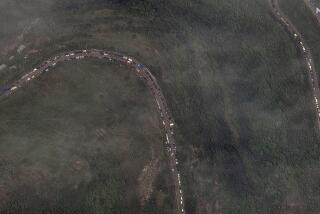INFRASTRUCTURE : New Pipeline a Conduit of Hope for Central Asia : Five former Soviet republics are banking on the as-yet-unbuilt channel, along with new railways and highways, to break free from Moscow’s long domination.
- Share via
ASHGABAT, Turkmenistan — It was a bizarre ceremony in the middle of nowhere.
Invited guests stood in a circle around two sections of pipe, five feet in diameter, that rested on a bed of gravel in the desert. Black limousines rolled up one by one, and out climbed the leaders of Pakistan, Iran, Turkey, Azerbaijan and Turkmenistan, each stepping forward to dig up a shovelful of dirt. Then welders fitted the two steel cylinders together.
The rest of this would-be pipeline doesn’t exist.
But President Saparmurad A. Niyazov, in a move to drum up financing, staged the symbolic inauguration for VIPs on hand last month for his former Soviet republic’s independence day.
When--and if--completed, the pipeline will take some of Turkmenistan’s natural gas through Iran and Turkey to customers in Europe, bypassing the existing line through Russia.
It is one of a number of pipelines, highways and railroads planned with the aim of breaking Moscow’s economic control over former subjects in landlocked, resource-rich Central Asia.
“I hope this pipeline will be the first of many pipelines,” said Pakistani Prime Minister Benazir Bhutto, whose country is among those seeking trade and influence in this region of 53 million people.
Decades ago, the Soviet Union closed its southern borders and isolated the five Central Asian republics--Kazakhstan, Kyrgyzstan, Tajikistan, Turkmenistan and Uzbekistan--from their historic Asian trading partners.
Now the five are starting to grasp the advantages of rebuilding trade and transport links to the south, to lessen their dependence on those running north into Russia.
Turkmenistan hopes to get rich quick by selling gas to Europe. But so does Russia. With Russian hands on the tap, Turkmenistan has little control over where its gas goes. Most of it has been consumed by former Soviet republics Ukraine, Armenia and Georgia, which now owe Turkmenistan $2 billion and are too poor to pay.
Construction of the pipeline through Iran and Turkey is meant to start early next year.
But diplomats say financing from the West could be hard to find because of opposition there to any project that might benefit Iran.
Huge, oil-rich Kazakhstan has a similar problem, as its oil exports depend totally on Russian pipelines. Russia, an oil exporter itself, views Kazakhstan as a competitor and limits the flow of Kazakh oil.
As a result, Kazakhstan has formed a consortium with the Persian Gulf sultanate of Oman to build its own pipeline through Russian territory to the Black Sea.
Central Asians are also planning new transport lines for easier routes to the sea.
New tracks under construction will join Turkmenistan’s railway with the city of Mashhad in eastern Iran, giving Central Asia rail access to Iran’s port of Bandar Abbas.
At present, the nearest ports accessible to Central Asia by rail are in Russia--St. Petersburg on the Baltic Sea and Vladivostok on the Pacific, both thousands of miles away.
Pakistan, which wants Central Asian trade to flow through its own port of Karachi, is also discussing a railroad through western Afghanistan--a part of that country barely touched in recent years by the Afghan civil war.
The Afghan war has also delayed the opening of Pakistan’s most direct route to Central Asia, through Kabul to Uzbekistan.
But there is another obstacle: Uzbek President Islam A. Karimov, a cautious former Communist strongly suspicious of Islamic extremism, is wary about opening up too quickly to the Islamic south.
Other routes connecting Central Asia to Pakistan lead through western China, such as the Karakoram Highway. From there, two roads lead to Kazakhstan and Kyrgyzstan. Pakistan has discussed upgrading these roads with cooperation from China, which is also interested in more trade with Central Asia.
Like the isolated sections of pipe in the Turkmen desert, many of these proposed links are still in the speculative stage.
But officials in the region expect that at least some will be built, bringing an end to Central Asia’s era of Moscow-engineered isolation.
More to Read
Sign up for Essential California
The most important California stories and recommendations in your inbox every morning.
You may occasionally receive promotional content from the Los Angeles Times.













